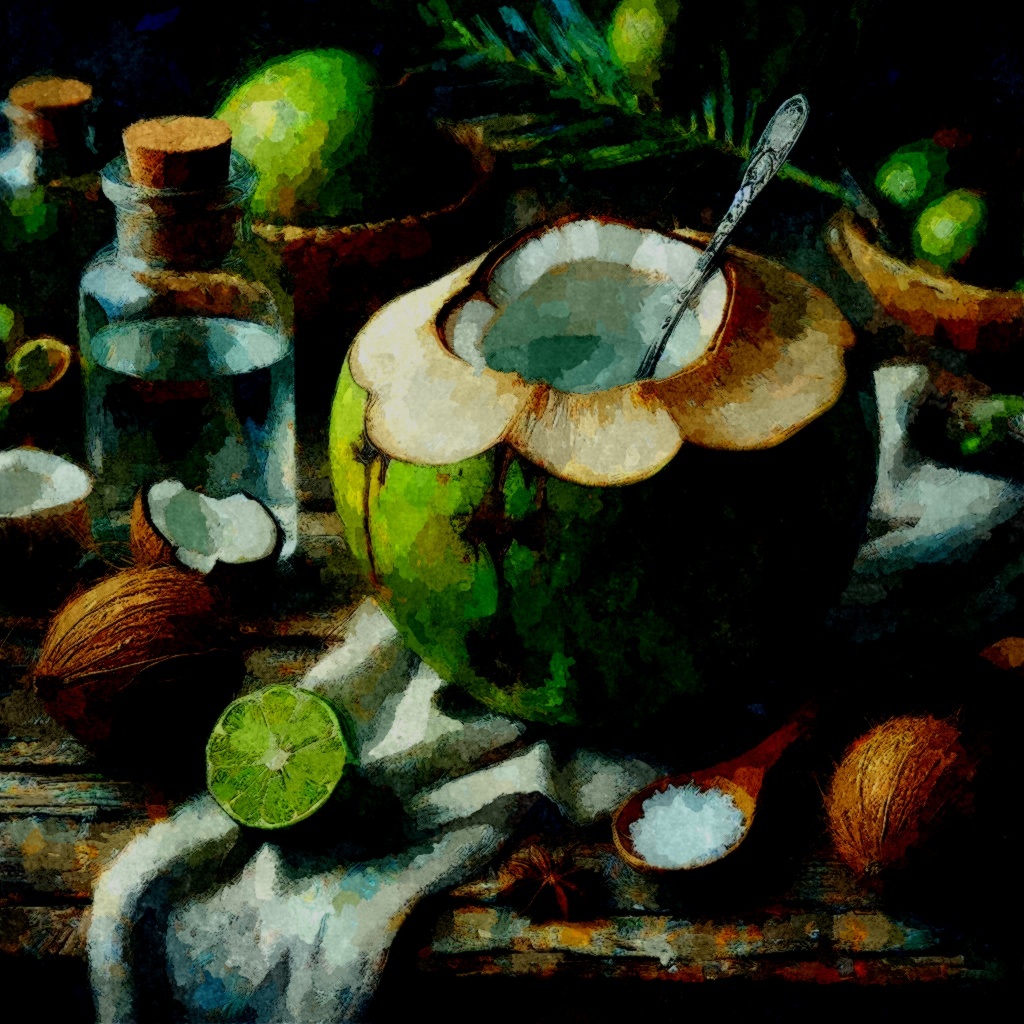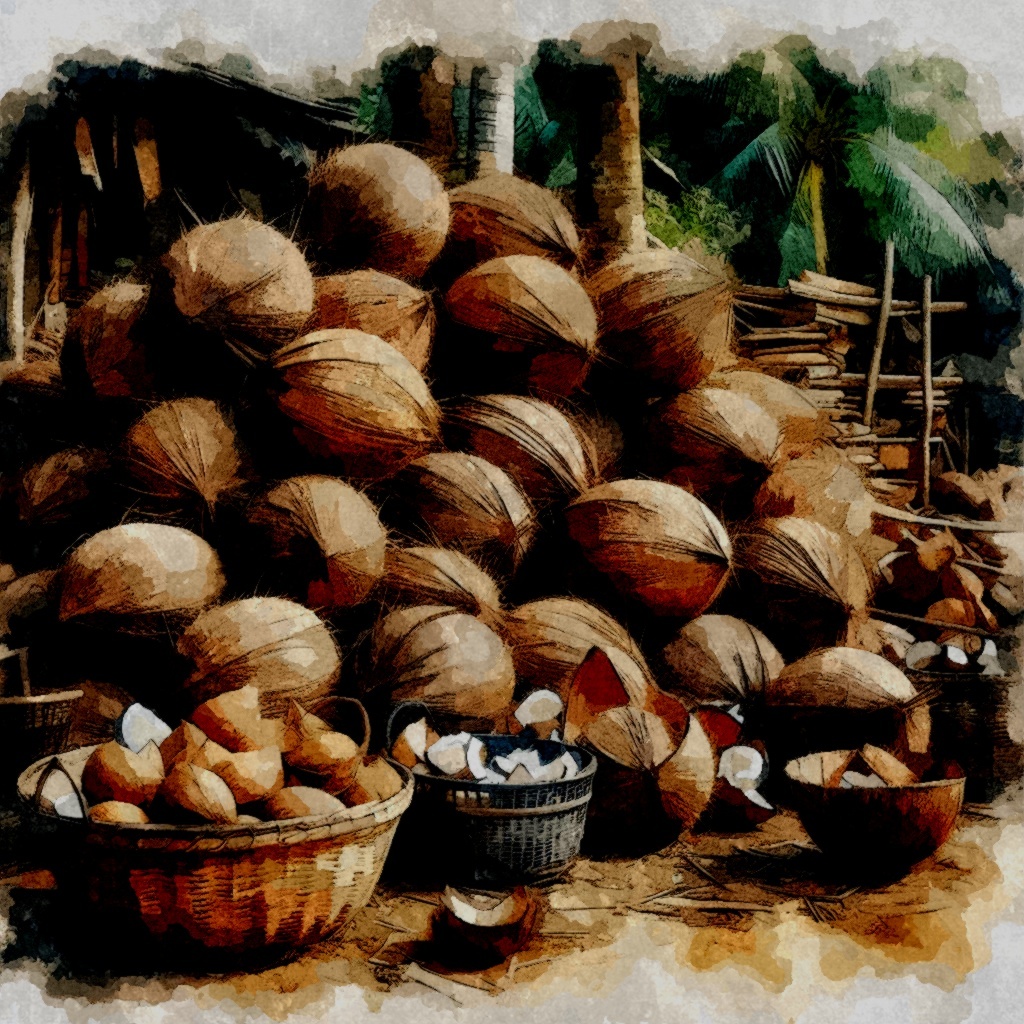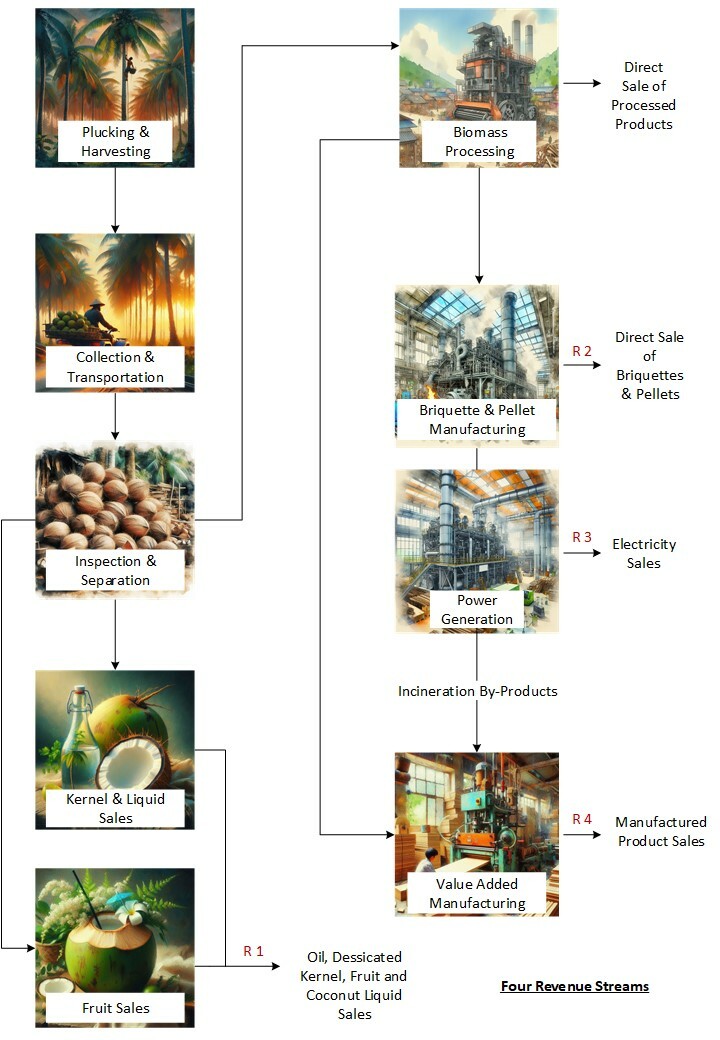

This coconut plantation pilot project will aim to establish a coconut plantation as an integrated facility maximising food production (oil, milk, health drink), while utilising the waste stream (shell, husk, frond) for manufacturing and energy production.
The Project will aim to optimise the output of a minimal footprint reference plantation to achieve 3 objectives –
A "No Plantation Waste" approach will be considered to recover and recycle the plantation waste stream for manufacturing or energy generation, thereby enhancing revenue.
This project will also consider the possibility of purchasing the production of neighboring smallholdings that would otherwise go to waste. In such circumstances this project could add downstream processing capacity, provided the investment can be justified, while simultaneously contributing to income enhancement for neighboring smallholdings.
Various planting options could be applied. Triangular, square, hedge and double hedge planting layout options could be applied depending on palm variety and site topography. The coconut palm, depending on palm variety, will remain in production for 40 - 70 years with minimal additional capital investment and low maintenance cost. Plantation output is non seasonal. Nuts and fronds will be produced throughout the year. The palm has a minimal footprint permitting intercropping with cereals, tubers, legumes, herbs and fruits thereby permitting optimal land utilisation.
Coconut palms are planted with adequate spacing ( 8m between palms) in well prepared soil in the wet season in an area with adequate rainfall (at least 60 inches of rain annually). The palms are provided adequate nutrition to provide regular high quality production. It is possible to plant 150 to 250 palms per hectare on a suitable site.

There are over 70 varieties of coconut palms ranging from tall palms that grow to 20 - 30 metres, and dwarf palms that reach a height of 2 -3 metres.
Some palms will take 4 - 6 years to bear fruit while other will begin to flower in 2 – 3 years.
Palms can be selected for the type of coconuts that are required. Some varieties produce superior quality coconut oil and high quality coconut fluid and kernel. Others have smaller harder shells and thicker husk. A mix of palm varieties could be planted to meet specific demand on a site of suitable size.
Palms have a wide range of coconut production with yields ranging from 60 – 120 coconuts per palm per year. Green coconuts are harvested early and yield the most coconut fluid and edible kernel. Mature coconuts take longer to develop, but provide higher quality oil, shell and husk.
The coconut fruit comprises 4 distinct components. The liquid and kernel are the food components and these are easily extracted. The husk is removed to expose the shell and has commercial value for a range of products. The shell is halved to first, recover the liquid, and then to separate the kernel. The kernel has multiple processing options. The residue shell has valuable manufacturing and energy generation applications. Click the button below to view the components of the coconut.
A wide range of products can be derived from the coconut fruit. The fruit can be sold without processing as a green coconut or mature nut. The mature nut can be sold partially or wholly dehusked. Alternatively various levels of processing can be carried out on each part of the coconut thereby adding commercial value. Click the button below to see the processing and product options.

The coconut shell is approximately 15% of the weight of a coconut, and has a calorific value of ~ 5500 kCal/kg. The shell can be used as fuel without pretreatment, converted to shell charcoal by combustion with limited oxygen, or briquetted. Shell charcoal can then be further processed with the application of steam to manufacture activated carbon.
Raw coconut shell sells for USD 0.85/kg to USD 1.20/kg and has a shelf life of 3 - 6 months. Shell charcoal also has a market value of USD 1.20/kg to USD 1.30/kg, but with a shelf life of 24 months. Coconut briquettes can be prepared for up to high calorific value smokeless home use and have a market value of between USD 1.50/kg - USD 2.50/kg. .
Coconut husk or fibre can also be used as fuel and when dried and compacted has a calorific value of ~ 4000 Kcal/kg. Alternatively, husk can be recycled and recovered for use as feedstock for manufacturing. Coconut husk chips, coir and peat sell for USD 0.20 /kg.

The coconut frond is a large leaf and is approximately 6m in length and weighs 2.7kg. Approximately 90% of the leaf is the petiole and will weigh approximately 2.2kg dry. A typical palm will produce 10 – 15 fronds a year. The energy contained in a petiole is approximately 4000 kcal/kg. If a palm produces 12 fronds per year each palm will yield 48,000 kcal/year from its petioles.
The frond is used for artisan work and household products. The frond can be sold as feedstock for the pulp and paper sector or for the manufacture of fibre board.

Estimates of the production of a plantation for given plantation sizes is shown in the document below. The number of coconuts and petioles generated annually have been estimated. In addition, estimates of coconut liquid, kernel, kernel oil and kernel meal have been assessed. The quantity of husk and shell available as by-products for further processing have been estimated. Click on the button below to view plantation production estimates.
The coconut offers a broad range of revenue options. The coconut can be sold immediately after harvesting as a green or mature coconut. Every step of further processing adds commercial value, but will incur additional capital investment and add operations and maintenance cost.
Processing can be carried out on the kernel, shell and husk. Investment in heat and power generation will be justified if sufficient biomass fuel is generated and a competitive biomass tariff can be contracted.
Additional capital investment is not required once the site has been prepared and the coconut palms are planted. As these palms mature and begin bearing fruits, the coconuts can be sold as green coconuts for the liquid and soft kernel or as mature coconuts to purchasers interested to extract the kernel for food, desiccated coconut or copra. Coconuts are sold with husk and shell.
Coconut fronds can be separately sold or will otherwise be disposed as agricultural waste.
Additional capital investment will be required to dehusk the coconuts and recover the husk before sale. If the shell is to be recovered, then investment will be needed to halve the dehusked coconuts, to extract the liquid and kernel for separate sale. The cleaned shell can then be processed for further revenue.
Alternative investment will be needed if virgin coconut oil is to be extracted and packaged.
The next level of revenue generation will require investment to produce coconut coir from the husk, used in the manufacture of mats, carpets and rope. Husk is also used to produce coconut peat used in hydroponic agriculture.
The coconut shell can also be sold for use in the manufacture of ornaments or for the manufacture of activated carbon and coconut charcoal. If these materials are to be converted in-house then additional investment must be made for further processing to enhance revenues.
Biomass power generation from the available agricultural sources will generate long term revenues. Palm fronds, husk and shell all have substantial potential due to their high calorific value. Briquettes and pellets manufactured on-site could also be used.
Click the button below to view the processing and product options.

The process workflow of an operational plantation commences with the harvesting, collection, inspection and separation of the coconuts. The workflow extends to the desired level of processing provided the additional investment is made. The coconuts can be sold directly as green or mature nuts.
Alternatively, the coconuts can be processed into liquid and kernel, with the separation and collection of shell and husk which are then utilised for biomass power generation, or used for manufacturing.
Potential revenue streams can be realised at various points in the process flow to extract added value revenues.

Revenue estimates for different coconut product options can be estimated for different plantation sizes from output projections assuming that investment in the associated processing infrastructure is made. Click on the button below to view the revenue estimates for various products for coconut plantations of different acreages.

Alternatively biomass power and heat generation could be prioritised from the plantations non-food production. These include the shell, husk and petiole. Click on the button below to view the biomass potential of a coconut plantation of different acreages.

Biomass power generation will require investment in the appropriate equipment for a small scale biomass fired power plant.
The key component will be a boiler capable of utilising mixed coconut by-products of varying calorific value, composition, moisture content and sizes as biofuel. The boiler should be able to generate sufficient steam of the required pressure and temperature for a condensing steam turbine.
Investment in a fuel preparation plant, cooling tower, ash handling system, electrical protection and switching panels, and an grid interconnection transformer yard will be required.

The power station will be sized to handle the available biomass fuel and take account of the tariff and dispatching requirements offered. In a suitable scenario it may be viable to prepare and store the fuel in pellet or briquette form to permit the plant to be operated optimally.
Click on the button below to view the potential revenue estimates for biomass power generation for a coconut plantation of different acreages.
The first step in advancing this project will be an application to the relevant authorities to secure any incentives that may be provided for an integrated coconut plantation project. Incentives with regard to grants, preferential financing and tax incentives may be available and will be explored as the first step of the development cycle. Agricultural and environmental credits may accrue for the rehabilitation of a suitable agricultural site to produce food products. Additional carbon credits may be available for the planting of the palms and for biomass generation from the plantation waste stream.
Once approvals have been secured, a suitable site will need to be identified with the required footprint of interest. A warm tropical climate with temperature in the 24ºC - 32°C range and well drained sandy loam, laterite or alluvial soils with a depth of at least 1.5m will be preferred. Road access for light trucks and availability of services and utilities will be required.
Access to a suitable medium voltage interconnection for power sales will also be required. Utility and grid approval for interconnection and a tariff structure for power sales will need to be secured.
Once these approvals have been secured the site can be acquired. A site survey, layout planning, site infrastructure and utilities planning and engineering design can be carried out next. Once the required permits and licences are secured, a nursery can be established and planting can commence. Once engineering works are completed financing can be secured and tenders issued.
After site works, installation and commissioning and performance testing are completed the plantation will be fully operational.
Click on the button below to view the timelines for the activities from the planning stage to final commercial operation.